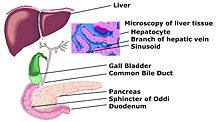Hepatologyis the branch ofmedicinethat incorporates the study ofliver,gallbladder,biliary tree,andpancreasas well as management of their disorders. Although traditionally considered a sub-specialty ofgastroenterology,rapid expansion has led in some countries to doctors specializing solely on this area, who are calledhepatologists.
| Occupation | |
|---|---|
| Names | Doctor, Medical Specialist |
Occupation type | Specialty |
Activity sectors | Medicine |
| Description | |
Education required |
OR OR OR AND AND AND |
Fields of employment | Hospitals,clinics |

Diseases and complications related toviral hepatitisand alcohol are the main reason for seeking specialist advice. More than two billion people have been infected withhepatitis Bvirus at some point in their life, and approximately 350 million have become persistent carriers.[1]Up to 80% ofliver cancerscan be attributed to either hepatitis B orhepatitis Cvirus. In terms ofmortality,the former is second only to smoking among known agents causingcancer.With more widespread implementation ofvaccinationand strictscreeningbeforeblood transfusion,lowerinfectionrates are expected in the future.[citation needed]In many countries, however, overall alcohol consumption is increasing, and consequently the number of people withcirrhosisand other related complications is commensurately increasing.[citation needed]

Scope of specialty
editAs for many medical specialties, patients are most likely to be referred by family physicians (i.e., GP) or by physicians from different disciplines. The reasons might be:
- Drug overdose.Paracetamol overdoseis common.
- Gastrointestinal bleedingfromportal hypertensionrelated to liver damage
- Abnormal blood test suggestingliver disease
- Enzymedefects leading to bigger liver in children commonly namedstorage diseaseof liver
- Jaundice/Hepatitisvirus positivity in blood, perhaps discovered on screening blood tests
- Ascitesor swelling ofabdomenfrom fluid accumulation, commonly due to liver disease but can be from other diseases like heart failure
- All patients with advanced liver disease e.g. cirrhosis should be under specialist care
- To undergoERCPfor diagnosing diseases of biliary tree or their management
- Feverwith other features suggestive of infection involving mentioned organs. Some exotictropicaldiseases likehydatid cyst,kala-azarorschistosomiasismay be suspected.Microbiologistswould be involved as well
- Systemic diseasesaffecting liver and biliary tree e.g.haemochromatosis
- Follow-up ofliver transplant
- Pancreatitis- commonly due to alcohol orgallstone
- Cancer of above organs. Usually multi-disciplinary approach is undertaken with involvement ofoncologistand other experts.
History
editEvidence from autopsies on Egyptianmummiessuggests that liver damage from theparasiticinfectionbilharziasiswas widespread in the ancient society.[2] It is possible that theGreeksmay have been aware of the liver's ability to exponentially duplicate as illustrated by the story ofPrometheus.However, knowledge about liver disease inantiquityis questionable. Most of the important advances in the field have been made in the last 50 years.[when?]
- In 400 BCHippocratesmentionedliver abscessinaphorisms.[3]
- RomananatomistGalenthought the liver was the principal organ of the body. He also identified its relationship with the gallbladder and spleen.[4]
- Around 100 CEAretaeus of Cappadociawrote on jaundice[5]
- In the medieval periodAvicennanoted the importance of urine in diagnosing liver conditions.
- In 1770, French anatomistAntoine Portalnoted bleeding due tooesophageal varices,[6]
- In 1844, Gabriel Valentin showed pancreatic juices break down food in digestion.
- 1846 Justus Von Leibig discoveredpancreatic juicetyrosine[5]
- 1862Austin Flintdescribed the production of"stercorin".
- 1875Victor Charles Hanotdescribed cirrhotic jaundice and other diseases of the liver[7]
- In 1958, Moore developed a standard technique forcanineorthotopicliver transplantation.[8]
- The first human liver transplant was performed in 1963 by Dr.Thomas E. Starzlon a three-year-old male afflicted withbiliary atresiaafter perfecting the technique on canine livers.[9][10]
- Baruch S. Blumbergdiscovered hepatitis B virus in 1966 and developed the first vaccine against it 1969. He was awarded theNobel Prize in Physiology or Medicine1976.[11]
- In 1989, investigators from the CDC (Daniel W. Bradley) and Chiron (Michael Houghton) identified the hepatitis C virus, which had previously been known as non-A, non-B hepatitis and could not be detected in the blood supply.[12]
- Only in 1992 was a blood test created that could detect hepatitis C in donated blood.[12]
The wordhepatologyis fromAncient Greekἧπαρ (hepar) or ἡπατο- (hepato-), meaning "liver", and -λογία (-logia), meaning "study".
Disease classification
edit1.International Classification of Disease(ICD 2007) – WHO classification:
- Chapter XI: Diseases of the digestive system[13]
- K70-K77 Diseases of liver
- K80-K87 Disorders of gallbladder, biliary tract and pancreas
2.MeSH (medical subject heading):sam
- G02.403.776.409.405same as "Gastroenterology"[14]
- C06.552 Liver Diseases[15]
- C06.130 Biliary Tract Diseases[16]
- C06.689 Pancreatic diseases[17]
3.National Library of Medicine Catalogue[18]
Also seeHepato-biliary diseases
Important procedures
editReferences
edit- ^"WHO | Hepatitis B".Retrieved2010-03-17.
- ^Rosalie David A, Contis G (1996). "Paleopathology on schistosomiasis in Egyptian mummies".Parasitol. Today (Regul. Ed.).12(4): 167.doi:10.1016/0169-4758(96)80811-8.PMID15275234.
- ^"Aphorisms.mb.txt".Archived fromthe originalon 11 February 2005.Retrieved30 November2021.
- ^"History of Liver, Gallbladder, and Spleen".Retrieved18 May2007.
- ^abH. S.J. Lee, ed. (1999).Dates in Gastroenterology: A Chronological Record of Progress in Gastroenterology over the Last Millennium (Landmarks in Medicine).Informa Healthcare.ISBN1-85070-502-X.
- ^Moodley J; Singh B; Lalloo S; Pershad S; et al. (2001)."Non-operative management of haemobilia".The British Journal of Surgery.88(8): 1073–76.doi:10.1046/j.0007-1323.2001.01825.x.PMID11488792.S2CID8124234.
- ^"Victor Charles Hanot".Whonamedit.com.Retrieved18 May2007.
- ^"eMedicine - History of Pediatric Liver Transplantation: Article by Beth A Carter, MD".Emedicine.com.Retrieved18 May2007.
- ^"History of Liver Transplantation".Archived fromthe originalon August 30, 2009.Retrieved8 September2009.
- ^STARZL TE; MARCHIORO TL; VONKAULLA KN; HERMANN G; et al. (1963)."Homotransplantation Of The Liver In Humans".Surgery, Gynecology & Obstetrics.117:659–76.PMC2634660.PMID14100514.
- ^"Baruch S. Blumberg - Autobiography".Nobelprize.org.Retrieved18 May2007.
- ^ab"Brief_History_HCV_10.pdf"(PDF).Archived fromthe original(PDF)on 2014-09-25.Retrieved2013-06-18.
- ^"Archived copy".Archived fromthe originalon 2009-04-22.Retrieved2020-10-05.
{{cite web}}:CS1 maint: archived copy as title (link) - ^"G02.403.776.409.405same as "Gastroenterology"".Nlm.nih.gov.Retrieved30 November2021.
- ^"Liver Diseases".Nih.gov.Retrieved24 December2016.
- ^"Biliary Tract Diseases".Nih.gov.Retrieved24 December2016.
- ^"Pancreatic Diseases".Nih.gov.Retrieved24 December2016.
- ^"NLM Classification Home Page".Nih.gov.Retrieved24 December2016.[permanent dead link]
- ^"NLM Classification Schedule WI".wwwcf.nlm.nih.gov.Archived fromthe originalon 19 October 2004.Retrieved17 January2022.
- ^"NLM Classification Schedule WI".wwwcf.nlm.nih.gov.Archived fromthe originalon 19 October 2004.Retrieved17 January2022.